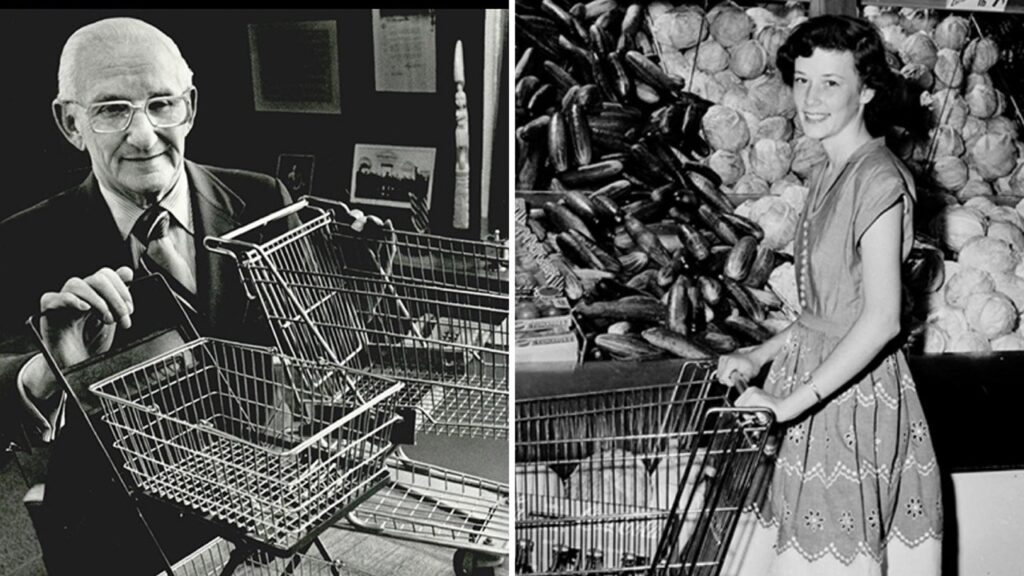One of the most profound conveniences that has shaped modern shopping culture was conceived during an era of significant adversity. Sylvan Goldman, the son of immigrant pioneers, introduced the shopping cart, a seemingly simple yet revolutionary invention. This idea emerged amid the struggles of the Great Depression and the ecological fallout from the Dust Bowl, prevalent in his home state of Oklahoma. Larry O’Dell, the state historian for the Oklahoma Historical Society, remarked on the brilliance of Goldman’s invention, stating, “The simplest inventions are always the most fascinating.” He emphasized the perplexing nature of why such an essential tool had not been created sooner, highlighting the profound impact that the shopping cart has had on American consumerism.
Goldman launched his invention in 1937, incorporating it into his chain of grocery stores known as Humpty Dumpty. At the time, the mid-1930s were marked by economic despair and the impending chaos of World War II, making it seem an unlikely period for innovation. However, Goldman’s shopping cart emerged not only as a tool for facilitating shopping but as a symbol of America’s consumer culture and prosperity. The Oklahoman newspaper paid tribute to him, declaring that his invention “revolutionized merchandising and changed the face of America” after his death in 1984.
Sylvan Nathan Goldman was born into humble beginnings on November 15, 1898, within the Chickasaw Nation, an area that is now part of Ardmore, Oklahoma. His family roots were steeped in immigration; his father, Michael Goldman, had come from Latvia, while his mother, Hortense Dreyfus, hailed from the conflict-ridden region of Alsace-Lorraine, which oscillated between French and German control. Michael Goldman’s journey began in Baltimore, Maryland, where he worked in a dry goods store before participating in the famous land rush of 1889 into what would become Oklahoma.
Growing up in a diverse environment largely dominated by Christian settlers, Sylvan Goldman was one of the few Jewish boys in his community, and his education was limited to the eighth grade. He learned the ins and outs of retail in the family dry goods store, where he honed his business acumen. Shortly after the United States entered World War I, Goldman enlisted in the Army, where he worked as a mess cook, utilizing his knowledge of food services to sustain his fellow soldiers on the front lines.
After the war, Goldman ventured into the grocery business with his brother Alfred, experiencing varying degrees of success across Texas, California, and Oklahoma. By 1934, they acquired the struggling Humpty Dumpty chain. Tragically, Alfred passed away in 1937, leaving Sylvan to spearhead the transformation of the grocery chain. It was during this pivotal time that Goldman conceived the idea for the shopping cart while experimenting in his carpentry workshop. His original design was a two-part unit featuring a traditional wire basket combined with a collapsible frame equipped with wheels.
On June 4, 1937, Goldman rolled out the shopping cart across Humpty Dumpty markets, yet the initial public reception was less than favorable. Many customers resisted the notion of using shopping carts. Women voiced their disapproval, stating, “I’ve pushed my last baby buggy,” while men felt that pushing a cart was not masculine enough. Undeterred, Goldman utilized marketing techniques – hiring women to demonstrate the carts in-store – to shift public perception. This clever strategy ultimately led to the shopping cart’s booming success.
Sylvan Goldman passed away on November 25, 1984, just one week after the death of his beloved wife, Margaret Katz Goldman. His innovative contributions to retail transformed shopping into a more convenient venture, culminating in a significant legacy that extends beyond mere groceries. Goldman’s wealth enabled him to support various philanthropic causes, including a generous gift of $1.5 million to the Oklahoma Blood Institute, which now continues its lifesaving work at the Sylvan N. Goldman Center.
Shopping carts have become a ubiquitous element of modern retail; it is estimated that at any given time, there are around 15 million shopping carts in use in American markets alone. Their influence even permeates the realm of online shopping, as terms like “shopping cart” have become standard nomenclature for digital purchase mechanisms, a testament to Goldman’s enduring impact on consumer behavior and convenience.
Goldman’s story epitomizes the immigrant experience of hard work and determination leading to success. His invention not only reshaped the way consumers interact with stores but also represented the spirit of innovation that defined a generation navigating hardship and economic uncertainty. The shopping cart, more than just a tool, serves as a symbol of the evolutionary journey of American retail and the indelible mark left by those who dare to dream and innovate.



